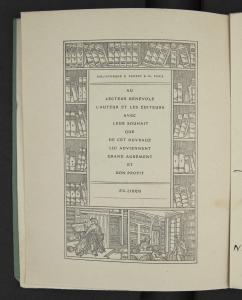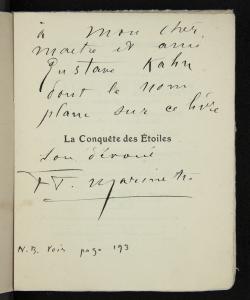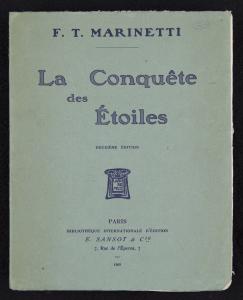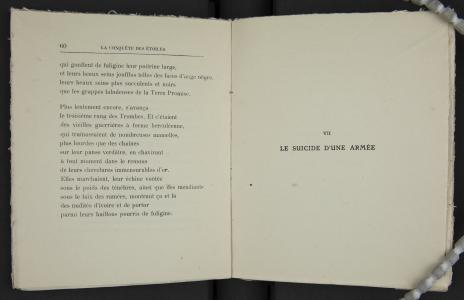

La conquête des étoiles : poème épique : suivi des jugements de la presse française et italienne / F.–T. Marinetti
1. The complaint, and the consolation; or, Night thoughts
2. The Fables of Æesop, and others / With designs on wood, by Thomas Bewick
5. News from nowhere: or, An epoch of rest, being some chapters from Utopian romance
6. The nature of Gothic, a chapter of the stones of Venice
7. Daphnis and Chloe: a most sweet abd pleasant pastoral romance for young ladies
8. The Sphinx
10. Credo
14. Bible.Old Testament. Song of Solomon.
16. Kem byt’? / V. Mai︠a︡kovskiĭ ; ris. N. Shifrin.
17. The ghost in the underblows
19. Bateau ivre
UCLA Call Number: PQ4829.M33 C7 1909
La conquête des étoiles : poème épique : suivi des jugements de la presse française et italienne / F.–T. Marinetti
La conquête des étoiles : poème épique : suivi des jugements de la presse française et italienne / F.–T. Marinetti
La conquête des étoiles : poème épique : suivi des jugements de la presse française et italienne / F.–T. Marinetti
The cover of Marinetti’s La conquête des étoiles illustrates the simplicity of materials and compositional layout used in a mass–market paperback book in the early 20th century. While sparse in purely decorative elements, a variety of clear modern and transitional typefaces are used to make the cover visually appealing to the consumer’s eye, while remaining easy to read.
La conquête des étoiles : poème épique : suivi des jugements de la presse française et italienne / F.–T. Marinetti
-->




Full title
Creator: Marinetti, F. T.
Publisher: E. Sansot & Cie
Publication Place: Paris
Date of Publication: 1909
Dimensions 18 cm x 14 cm
Physical Description:
UCLA's copy is the author's autographed presentation copy to Gustave Kahn.
The cover of Marinetti’s La conquête des étoiles is printed on blue paper with blue ink, and is simple in composition. The author’s name appears at the top in dark letters, the title is in an outlined typeface with a lighter fill. The publisher’s trademark, a simple image with letters spelling “laboremus” appears in the center of the page. Other edition and publication information are presented in a variety of smaller fonts. All of this information is vertically centered on the page, except a single word in the title that is placed off–center, creating visual interest. While the font is uniform throughout the main body of the text, the cover of the book incorporates a variety of Transitional and Modern styles of Roman and Italic typefaces that vary in thickness of serifs as well as in the level of contrast between thick and thin points of the letters.
The absence of illustrations, special materials, or decorative bindings or end pages suggests that this paperback book was most likely inexpensive to produce and distribute. The standard trademark of the E. Sansot & Cie publishing house is modest in size but centralized on the cover; subtle and minimal ornamentation appears on the spine. The book is small, light, and easy to handle. The modest means of production and the pocket–size of the book means that it offered intimacy, portability, and affordability to the reader at a time when readership had reached an unprecedented high and mass transportation allowed shorter, more comfortable travel. The price (3 fr. 50) is unabashedly advertised on the spine of the book itself, calling attention to its affordability and identity as an object of consumption.
Provenance: Unknown.Condition:
While discoloration from age and minor stains can be noted throughout, the UCLA Special Collections copy is in overall good condition with secure hinges and pages with no excessive wear or damage.
Additional Info:
The UCLA Special Collections copy of La conquête des étoiles is the author’s autographed presentation copy with a handwritten inscription personally addressed to Gustave Kahn. The book is published by E. Sansot & Cie, a French firm that produced a number of books by French authors between 1904 and 1912. The covers of La conquête des étoiles feature marketing elements such as the publisher’s trademark, as well as an advertising column that promotes other works written by Marinetti. The layout and composition are standard for all volumes issued by E. Sansot & Cie.
Interpretation:
An “epic poem” in narrative form by the Italian poet Filippo Tommaso Marinetti, this second edition of La conquête des étoiles (The Conquest of the Stars) represents a prototypical manifestation of poetry text in a predominantly Symbolist tradition at almost the exact chronological point when Marinetti himself renounces the sensuality and mysticism of Symbolism and thenceforth begins to espouse a new philosophy known as Futurism. Originally published in 1902, this second edition was produced in 1909, the same year of the infamous publication of Marinetti’s first Futurist manifesto in the widely–read French newspaper, Le Figaro. La conquéte des étoilesis striking in its conceptual juxtaposition against the radical ideas that Marinetti himself sets forth throughout the extent of Futurism from 1909 to approximately the end of World War I.
Marinetti’s aggressive call for political and societal reform and the exuberant glorification of modern technology, dynamism, violence, and fragmentation that were thematic in his numerous Futurist manifestos are a radical leap away from the Symbolist values embodied in La conquéte des étoiles. Despite Futurists’ fervent rejection of the lyricism and subjectivity of Symbolist poetry, La conqué te des étoiles is evidence of Marinetti’s intimate former ties with the Symbolist tradition. The themes in La conquête des étoiles are heroic and metaphorical, with expressive language that conjures and personifies nature (e.g., “the ominous chants of the waves”). His earlier devotion is also explicit in his personal dedication of the book to his mentor Gustave Kahn, a key French Symbolist poet.
Indeed, Symbolist influence throughout visual and literary works in Futurism and beyond cannot be ignored. For instance, Marinetti’s concept of parole in libertà, or “words in freedom,” is in direct dialogue with the Symbolist notion of vers libre, or “free verse,” which he wholly embraces in La conquête des étoiles. As such, the break from the past toward which Futurists ardently aspired was, in reality, not absolute; they would “challenge and defeat the preciosity of Symbolist aesthetic ideals while retaining the poetic freedom associated with those ideals. This freedom was exemplified… by a loosening of the classical structure of the alexandrine, which allowed for greater rhythmic variety and attention to the purely sonorous qualities of words.” [Footnote 1]
The physical and conceptual manifestation of La conquête des étoiles also reveals Marinetti’s relationship to the established systems of book production. The static alignment of text and margins, the logical organizational structure, and the familiar usage of typography reflect a rather surprisingly docile acquiescence to the mass–market book production practices of the time. This discrepancy between Marinetti’s later violent philosophy and relative tameness in practice represented by this book may also be indicative of what some critics suggest as the comparative slowness of Futurism in bringing ideas into fruition through a coherent and uniform practice. [Footnote 2] More revealingly, Marinetti’s use of this mainstream avenue for disseminating his work shows that he did not shun modern avenues for mass communication but rather embraced and utilized the mechanism as a tool for propagating the Futurist agenda. Indeed, the manifestos that began producing in 1909 maximized the use of this mechanism.
Later Futurist and poetic works, such as Marinetti’s own Zang Tumb Tuuum (1914), emphasized and experimented with the visuality and sounds of words rather than their imbued meaning. In his 1913 manifesto “Destruction of Syntax – Imagination without Strings – Words–in–Freedom,” Marinetti imagines the individual “in a zone of intense life (revolution, war, shipwreck, earthquake, and so on).” The man in this scenario would be “brutally destroying the syntax of his speech. He wastes no time in building sentences. Punctuation and the right adjectives will mean nothing to him. He will despise subtleties and nuances of language. Breathlessly he will assault your nerves with visual, auditory, olfactory sensations… the rush of steam–emotion will burst the sentence’s steampipe, the valves of punctuation, and the adjectival clamp. Fistfuls of essential words in no conventional order.” [Footnote 3] To Marinetti, this illustration represented the ideal form of expression. His call for an urgent and fragmented mode of expedient and forceful language, in the context of the period’s simultaneous evolutions in visual and linguistic theory and increasing tendencies toward abstraction in the arts, sparked a wave of subsequent experimentations in innovative typography and the liberal spatial exploration of the printed page as ways to imbue literary text with the immediacy of communication that had only been attributed to visual imagery until that point. [Footnote 4]
1. Christine Poggi, In Defiance of Painting: Cubism, Futurism, and the Invention of the Collage. New Haven: Yale University Press. 1992.
2. Hal Foster, Rosalind Krauss, Yve-Alain Bois, Benjamin H. D. Buchloh, Art Since 1900: Modernism, Antimodernism, Postmodernism, volume 1 1900-1944. New York: Thames & Hudson. 2004.
3. Umbro Apollonio, ed., Futurist Manifestos, London: Thames and Hudson. 1973.
4. Johanna Drucker,The Visible Word: Experimental Typography and Modern Art, 1909-1923. Chicago: University of Chicago Press. 1996.